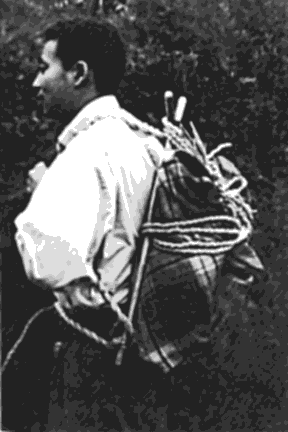
How would you like a pack frame that is comfortable, strong, and can be made from natural materials in less than 1/2 hour? We were introduced to the Roycroft pack by Mors Kochansky at the Rabbitstick Rendezvous a few years ago.

Its an excellent lesson in self sufficiency, outdoor survival skills, knifecraft, lashing, multiple use of an object (blanket) and use of natural materials. What more do you want? But is it primitive? I don't know if our stone age ancestors actually made this type of pack frame. We do know, however, that the "Iceman", whose remains were found after 5,300 years in the Alps between Italy and Austria, had with him a wood pack frame (1, 2, 3. See drawing also). The archaeologists have released very few details on his pack frame but say that it was an inverted U shape. I also saw a photo taken in the Himalayas early in the 1900's of a simple inverted U-shaped pack frame. The Koreans have been using A-frame packs for centuries.
Essentially we are lashing together a triangular wood frame, wrapping our belongings in a blanket and tying the bundle to the frame. A single piece of thick cordage is then used as combination shoulder straps and waist band
The Frame
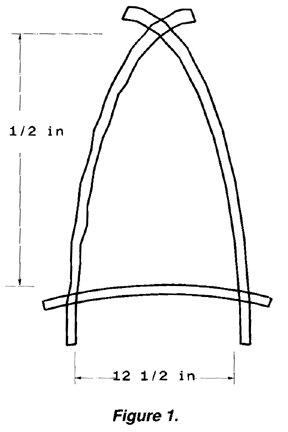
Cut three sticks for the frame. They should be about as thick as your thumb. The length of the bottom piece should be the width of your buttocks. Ideally it should also be slightly curved to fit your back. The length of the two side pieces should be equal to or slightly longer than the distance from your buttocks to the back of your head. I have heard of other ways to select the lengths but this works for me. In the past I have used green willow (Salix sp.) because it was available in the correct diameter, straight, plentiful and easy to cut and if necessary, bend. The Iceman's pack frame was made from hazelnut and larch. Hazelnut is a much tougher wood than willow. The three sticks are held together by a combination of joints and lashing. Figure 1 shows detailed dimensions of the pack that works best for me. As a reference point I am 5'8" tall and weigh 140 pounds. If the pack frame is too short, then a greater fraction of the weight will be carried by your shoulders. If it is too long, then the shoulder straps will be very loose and the load will wobble from side to side.
Figure 2 shows two different kinds of joint that can be used to hold the sticks together, the lap (Abe Lincoln) joint or the butterfly joint, another Mors Kochansky original (4). I don't see much difference between the two but the lap joint is possibly more appropriate if you have weak wood and strong cordage, whereas the butterfly joint works well if you have stronger wood and/or weaker cordage. My frame uses a lap joint on top and butterfly joints on the two bottom joints.
The lashing material can be any kind of vegetable fiber cordage or rawhide. It doesn't even have to be very strong if the joints are tight. One joint on my pack is put together with finely shredded cattail leaf fiber, another with New Zealand flax and the third with willow bark cordage. Figure 3 shows one possible way of lashing. It isn't very critical since most of the strength should come from the joint.
The original strap for my pack frame was made from a worn out Volvo seat belt plus a piece of nylon rope. Strong, durable and comfortable but it wasn't very primitive. The strap I am now using is two-ply shredded cattail (Typha sp.) leaf rope. It is made with the middle part, used for the shoulder straps, thicker than the ends. For comfort, the straps should be at least one inch (2.54 cm) in diameter. The straps should taper down to 1/2 inch after they leave the shoulders to facilitate tying them around your waist.
Making straps out of cattail leaves is a good lesson in cordage techniques. Making a piece of cordage can be an abstract exercise which doesn't mean much if you have no specific application for the cordage however making a piece of cordage for a particular application combines the "How to make it" with the "What do I use it for after I've made it?". For optimum results gather the cattail leaves late in the growing season, before they have died and turned brown (5). Shred them into narrow strips. A coarse "comb" made by driving nails into a board is a useful tool for the shredding. Otherwise it can be done by hand. Finely shredded fibers will be stronger and more flexible. After shredding, the fibers should be dried and then moistened before twining.
Three-ply braided versus two-ply twined straps: take your choice. The important things are that the cattail leaves should be shredded finely to give flexibility and the straps should be thick enough to give comfort.
Packing and tying on the load:
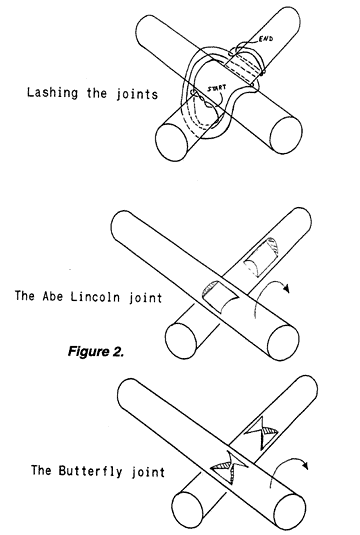
You want to pack your load in such a way that it is comfortable and everything is readily accessible without having to take it all apart. The best way I have found so far is to wrap up your gear the same way you would a baby. Another analogy is to say the blanket is folded like an envelope. Fold your blanket into a square and place it on top of the pack frame with the corners up, down, left and right. Place something soft, such as a coat or sweater, at the bottom for padding where it will contact your lower back. This is very important. Otherwise the crosspiece digs into your lower back. Put the rest of your gear on the blanket. Fold up the bottom corner, and then wrap the left and right corners around the gear. Last, fold the top corner down. This way it is easy to access anything by lifting up the top corner.
Tying the pack to the frame: Begin securing the load to the pack frame by first tying a rope to the center of the crosspiece. The load is then tied on in accordance with Figure 4. It is critical to tighten the rope sufficiently that some of the soft padded portion of the pack protrudes through to keep the crosspiece from contacting your lower back. That is shown in Figure 5.
Securing the straps:
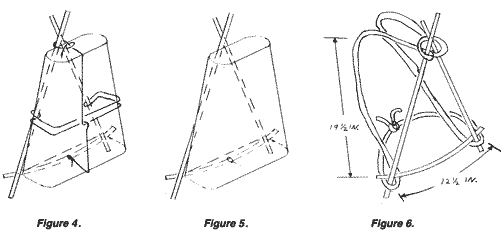
Secure the center of the straps to the top of the pack as shown
in Figure 6. It can be done as illustrated or with a "lark's
head" knot. The straps then go over your shoulders, around
the bottom of the side pieces and then are tied around your waist.
Once the straps are tied together you can leave the knot in place
and remove the pack simply by slipping the straps off the bottom
of the side pieces.
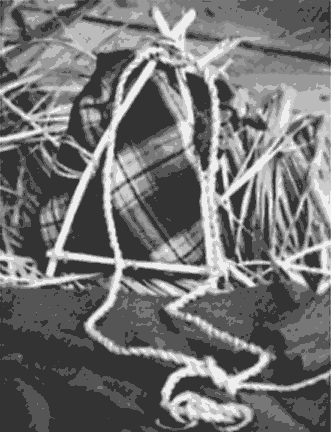
Field testing: My first real experience with a Roycroft pack was on a two week BOSS walkabout in south eastern Utah. I was using the Roycroft whereas my compadres were using very simple blanket packs. None of us had very heavy loads. One big advantage of the Roycroft over the simpler pack was the ease with which you could untie the pack, add something or take something out, and then re-tie it and be on your way. The other advantage was greater comfort.
My next test of the Roycroft pack was to see how it did with a heavier load. I packed a heavy coat and 25 pounds (11.36 kilograms) of books in the Roycroft and took off on a 1 1/2 hour hike in the hills. This is where I learned that narrow straps don't work well. It is also important that there be enough padding in the bottom of the pack to keep the cross piece off your tail. Other than that it works great.
Footnotes
(l.) 1993, "The Iceman", National Geographic, June,
page 36.
(2.) 1993, "Who Was the Iceman?", Popular Science, February,
page 46.
(3.) 1992, "The Long-Lost Hunter", Audubon, September-October,
page 92.
(4.) Mors Kochansky, "Northern Bushcraft", Lone Pine
Publishing, ISBN # 0-919433-51-0.
(5) 1994, "SPT Fall Bulletin", pages 10- 17
Iceman's Backpack
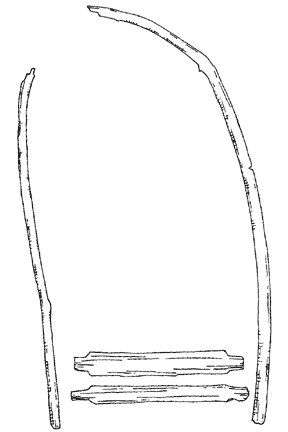 Drawn to scale from
photos in "The Man In The Ice" by Konrad Spindler, 1994
Drawn to scale from
photos in "The Man In The Ice" by Konrad Spindler, 1994
Cross boards - Larch (Larix decidua). Only faces show traces
of being worked. Boards were split from small branches.
Top board - 38.3 cent. long x 6.1 cent. wide x 1.2 cent. thick.
Bottom board - 40.5 cent. long x 4.6 cent. wide x O.6 cent. thick.
All boards had rounded end notches like bottom right.
Rod - Hazel (Corylus avellana) 1.98 meters long.
This article was first published in The
Bulletin of Primitive Technology (Spring 1995, #9)
E-mail your comments to "Richard A. Baugh" at richardbaugh@att.net
We hope the information on the PrimitiveWays website is both instructional and enjoyable. Understand that no warranty or guarantee is included. We expect adults to act responsibly and children to be supervised by a responsible adult. If you use the information on this site to create your own projects or if you try techniques described on PrimitiveWays, behave in accordance with applicable laws, and think about the sustainability of natural resources. Using tools or techniques described on PrimitiveWays can be dangerous with exposure to heavy, sharp or pointed objects, fire, stone tools and hazards present in outdoor settings. Without proper care and caution, or if done incorrectly, there is a risk of property damage, personal injury or even death. So, be advised: Anyone using any information provided on the PrimitiveWays website assumes responsibility for using proper care and caution to protect property, the life, health and safety of himself or herself and all others. He or she expressly assumes all risk of harm or damage to all persons or property proximately caused by the use of this information.
© PrimitiveWays 2013